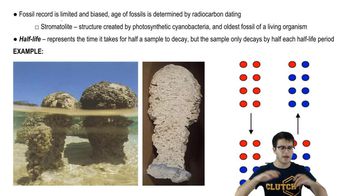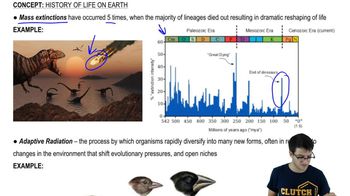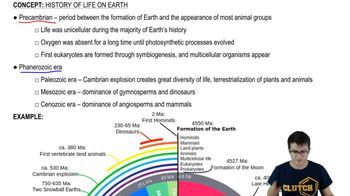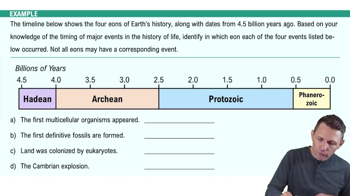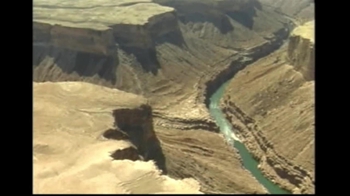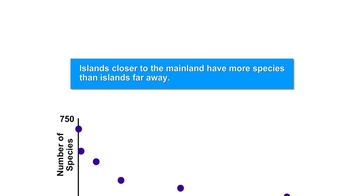Table of contents
- 1. Introduction to Biology2h 42m
- 2. Chemistry3h 40m
- 3. Water1h 26m
- 4. Biomolecules2h 23m
- 5. Cell Components2h 26m
- 6. The Membrane2h 31m
- 7. Energy and Metabolism2h 0m
- 8. Respiration2h 40m
- 9. Photosynthesis2h 49m
- 10. Cell Signaling59m
- 11. Cell Division2h 47m
- 12. Meiosis2h 0m
- 13. Mendelian Genetics4h 44m
- Introduction to Mendel's Experiments7m
- Genotype vs. Phenotype17m
- Punnett Squares13m
- Mendel's Experiments26m
- Mendel's Laws18m
- Monohybrid Crosses19m
- Test Crosses14m
- Dihybrid Crosses20m
- Punnett Square Probability26m
- Incomplete Dominance vs. Codominance20m
- Epistasis7m
- Non-Mendelian Genetics12m
- Pedigrees6m
- Autosomal Inheritance21m
- Sex-Linked Inheritance43m
- X-Inactivation9m
- 14. DNA Synthesis2h 27m
- 15. Gene Expression3h 20m
- 16. Regulation of Expression3h 31m
- Introduction to Regulation of Gene Expression13m
- Prokaryotic Gene Regulation via Operons27m
- The Lac Operon21m
- Glucose's Impact on Lac Operon25m
- The Trp Operon20m
- Review of the Lac Operon & Trp Operon11m
- Introduction to Eukaryotic Gene Regulation9m
- Eukaryotic Chromatin Modifications16m
- Eukaryotic Transcriptional Control22m
- Eukaryotic Post-Transcriptional Regulation28m
- Eukaryotic Post-Translational Regulation13m
- 17. Viruses37m
- 18. Biotechnology2h 58m
- 19. Genomics17m
- 20. Development1h 5m
- 21. Evolution3h 1m
- 22. Evolution of Populations3h 52m
- 23. Speciation1h 37m
- 24. History of Life on Earth2h 6m
- 25. Phylogeny2h 31m
- 26. Prokaryotes4h 59m
- 27. Protists1h 12m
- 28. Plants1h 22m
- 29. Fungi36m
- 30. Overview of Animals34m
- 31. Invertebrates1h 2m
- 32. Vertebrates50m
- 33. Plant Anatomy1h 3m
- 34. Vascular Plant Transport1h 2m
- 35. Soil37m
- 36. Plant Reproduction47m
- 37. Plant Sensation and Response1h 9m
- 38. Animal Form and Function1h 19m
- 39. Digestive System1h 10m
- 40. Circulatory System1h 57m
- 41. Immune System1h 12m
- 42. Osmoregulation and Excretion50m
- 43. Endocrine System1h 4m
- 44. Animal Reproduction1h 2m
- 45. Nervous System1h 55m
- 46. Sensory Systems46m
- 47. Muscle Systems23m
- 48. Ecology3h 11m
- Introduction to Ecology20m
- Biogeography14m
- Earth's Climate Patterns50m
- Introduction to Terrestrial Biomes10m
- Terrestrial Biomes: Near Equator13m
- Terrestrial Biomes: Temperate Regions10m
- Terrestrial Biomes: Northern Regions15m
- Introduction to Aquatic Biomes27m
- Freshwater Aquatic Biomes14m
- Marine Aquatic Biomes13m
- 49. Animal Behavior28m
- 50. Population Ecology3h 41m
- Introduction to Population Ecology28m
- Population Sampling Methods23m
- Life History12m
- Population Demography17m
- Factors Limiting Population Growth14m
- Introduction to Population Growth Models22m
- Linear Population Growth6m
- Exponential Population Growth29m
- Logistic Population Growth32m
- r/K Selection10m
- The Human Population22m
- 51. Community Ecology2h 46m
- Introduction to Community Ecology2m
- Introduction to Community Interactions9m
- Community Interactions: Competition (-/-)38m
- Community Interactions: Exploitation (+/-)23m
- Community Interactions: Mutualism (+/+) & Commensalism (+/0)9m
- Community Structure35m
- Community Dynamics26m
- Geographic Impact on Communities21m
- 52. Ecosystems2h 36m
- 53. Conservation Biology24m
24. History of Life on Earth
History of Life on Earth
Problem 5`
Textbook Question
Which of the following steps has not yet been accomplished by scientists studying the origin of life?
a. Synthesis of small RNA polymers by ribozymes
b. Formation of molecular aggregates with selectively permeable membranes
c. Formation of protocells that use DNA to direct the polymerization of amino acids
d. Abiotic synthesis of organic molecules
 Verified step by step guidance
Verified step by step guidance1
Understand the context of the problem: Scientists studying the origin of life are trying to recreate the conditions and processes that could have led to the formation of life on Earth. This involves several key steps, including the synthesis of organic molecules, formation of protocells, and the development of genetic material.
Review each option to determine what has been accomplished: Option (a) refers to the synthesis of small RNA polymers by ribozymes, which has been demonstrated in laboratory settings. Ribozymes are RNA molecules that can catalyze chemical reactions, including the formation of RNA strands.
Consider option (b): Formation of molecular aggregates with selectively permeable membranes has been achieved. Scientists have created vesicles or liposomes that mimic cell membranes, allowing selective passage of substances, which is a crucial step in forming protocells.
Evaluate option (c): Formation of protocells that use DNA to direct the polymerization of amino acids is a more complex step. While protocells have been created, the integration of DNA to direct protein synthesis is a significant leap that has not been fully realized in experimental settings.
Assess option (d): Abiotic synthesis of organic molecules has been accomplished, as demonstrated by experiments like the Miller-Urey experiment, which showed that simple organic compounds could be formed from inorganic precursors under prebiotic conditions.
 Verified video answer for a similar problem:
Verified video answer for a similar problem:This video solution was recommended by our tutors as helpful for the problem above
Video duration:
1mPlay a video:
Was this helpful?
Key Concepts
Here are the essential concepts you must grasp in order to answer the question correctly.
Abiotic Synthesis of Organic Molecules
Abiotic synthesis refers to the formation of organic molecules without the involvement of living organisms. This process is crucial in theories about the origin of life, suggesting that simple organic compounds could form under prebiotic conditions, such as in the primordial soup or on early Earth, providing the building blocks for more complex molecules.
Recommended video:
Guided course

Organization of DNA in the Cell
Ribozymes and RNA World Hypothesis
Ribozymes are RNA molecules capable of catalyzing specific biochemical reactions, similar to protein enzymes. The RNA world hypothesis posits that self-replicating ribozymes were crucial in early life forms, potentially leading to the synthesis of small RNA polymers. This concept supports the idea that RNA could have been the first genetic material, preceding DNA and proteins in evolutionary history.
Recommended video:
Guided course

Predictions, Hypotheses, & Theories
Protocells and Selectively Permeable Membranes
Protocells are simple, cell-like structures that exhibit some properties of living cells, such as a selectively permeable membrane. These structures are thought to have played a role in the origin of life by providing a controlled environment for chemical reactions. The formation of protocells is a key step in understanding how non-living chemical compounds could transition into living organisms.
Recommended video:
Guided course

Introduction to Membrane Transport
Related Videos
Related Practice





